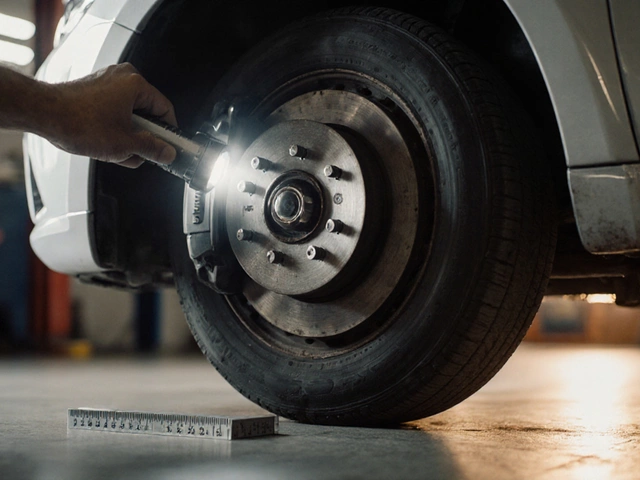Ever wondered if your car's bumpy ride could mess with the engine under the hood? It's not just about comfort. Your vehicle's suspension system is like the unsung hero, cushioning every drive, but it also plays a sneaky role in engine performance.
When your suspension goes bad, it doesn't just make for an uncomfortable drive. It can actually knock other car parts out of alignment, including the engine. This misalignment can stress the engine, making it work harder than it should.
Think of it like wearing shoes with no padding all day long. Sure, your feet feel the pain, but it can also lead to discomfort in your legs and back. Similarly, a bad suspension can cause a ripple effect through your car. So, keeping an eye on those shocks and struts isn't just about smooth rides but could save you from hefty engine repairs down the road.
- The Role of Suspension
- How Suspension Issues Creep into Engine Health
- Warning Signs of Bad Suspension
- Practical Tips for Maintaining Your Suspension
The Role of Suspension
Your car's suspension is like its backbone, keeping everything in line and smoothing out those pesky bumps and jolts from rough roads. It's not just about comfort—it's about control and safety, too. The suspension system helps your tires maintain contact with the road, which is crucial for handling and stopping the vehicle effectively.
The key components of a suspension system include springs, shocks, and struts. Springs carry the vehicle's weight and absorb large shocks from road imperfections. Shocks and struts are there to dampen the bounce, offering stability and control. Here's where it gets interesting: the suspension problems can indirectly affect your car's engine.
When parts of the suspension wear out or fail, it can lead to uneven tire wear, pulling to one side, or even strange noises. But it might also lead to vibrations and poor alignment, which can stress the engine. If the car's body sways or dips too much, it causes undue strain on engine mounts and could even disrupt other components under the hood.
Maintaining your car maintenance routine and checking the suspension regularly can prevent these issues from snowballing. Since the suspension impacts everything from ride quality to engine health, not paying attention to it could lead to some unexpected headaches. Stay proactive and keep an eye on these parts to keep your vehicle purring smoothly.
How Suspension Issues Creep into Engine Health
So, you've got some bad suspension going on and think it's just about a rough ride? Think again. An unhealthy suspension can sneak its way into affecting your engine in some surprising ways.
Imagine hitting a bump or pothole. Your suspension should absorb that shock, letting your car glide smoothly on. But if it's worn out, that impact transfers more to the frame, and yes, even to the engine. Each jolt can shift and shake engine components, leading to misalignment. Misaligned parts need extra effort to work together, and this extra strain reduces their lifespan and efficiency.
But that’s not all. A poorly functioning suspension can mess with your vehicle's handling, leading to uneven tire wear. When your tires wear out in an unbalanced way, the engine's workload increases again, as it struggles to maintain a steady torque and power transmission.
Let’s look at some interesting figures:
| Component | Effect on Engine | Repair Costs ($) |
|---|---|---|
| Misaligned Suspension | Engine efficiency drop | 200-400 |
| Uneven Tire Wear | Increased fuel consumption | 200-600 |
Beyond just dollars, think about the time and effort you save by sorting out your suspension issues early. Addressing these problems can prevent engine parts from wearing out prematurely, offering a smoother drive and potentially saving hundreds on repairs. It's like making sure a domino doesn’t topple the entire row.
Tell-tale signs like increased stopping distances, pulling to one side, or a shaky steering wheel could all hint at suspension problems. Spotting these early can make all the difference in keeping both your suspension and engine in tip-top shape.

Warning Signs of Bad Suspension
Noticing something's off with your car is crucial, especially when it comes to your suspension. Ignoring these warning signs might not just cost you comfort but could hit your wallet hard with engine repairs.
Suspension problems usually make themselves known through some pretty obvious clues. First up, if your car starts feeling like a bounce house, where every little bump in the road seems exaggerated, it's a clear sign your shocks or struts could be in trouble.
Have you been hearing odd noises like clunking or knocking every time you go over a bump or turn a corner? These sounds often mean your suspension components are wearing out or something's loose. Trust me, it's not just an annoying sound; it's a plea for help from your car.
Another red flag is uneven tire wear. When your suspension system isn't doing its job well, the tires face uneven pressure, causing them to wear out faster on one side. This doesn't only mean you'll need to replace them sooner, but it also puts extra stress on other car parts.
Don't ignore the nose dives, squat, or excessive body roll. A vehicle that dips forward when braking hard or squats backward during acceleration tells you the suspension can't handle the vehicle's weight effectively.
- Increased stopping time or distance can also hint at suspension problems. A messed-up suspension can alter your vehicle’s weight distribution, making it harder to brake quickly.
- Finally, if your car drifts or pulls to one side, especially on smooth roads, it's another suspension red flag. This often means your alignment's out, which ties back to the suspension system.
When it comes to cars, catching these signs early can save you from bigger headaches down the line. Keeping your engine health intact involves regular check-ups of these suspension issues. So, next time you feel that bump, don't just hold on and hope for the best. Get it checked out!
Practical Tips for Maintaining Your Suspension
Keeping your car's suspension in tip-top shape isn't just about enjoying a smooth ride—it's about protecting that precious engine. So, what's the secret sauce to giving your suspension the TLC it deserves?
First up, regular inspections are key. Spotting issues like leaks in the struts or shocks early can save you a ton of trouble. At least once a year, or along with your regular car service, have a pro check your suspension components.
Here's a biggie: don't ignore weird noises. Clunks over bumps or creaks during turns? They might mean suspension parts are wearing out. It's like your car's way of waving a red flag.
Another tip? Keep an eye on tire wear. Uneven wear could mean alignment issues, which often tie back to your suspension. Rotating tires and aligning them properly can sidestep bigger problems.
"Preventive maintenance is not just about fixing problems when they occur. It's about ensuring that problems are less likely to happen at all," says James Sullivan, a well-known figure in automotive repair.
Then there's driving habits. Hard braking and aggressive turns put extra stress on the suspension. Drive a bit gentler, and it'll thank you later.
- Avoid overloading your vehicle. Too much weight can wear down suspension components faster.
- Use quality replacement parts. Stick to reputable brands when it's time to swap out worn parts.
- Check your car's manual. Follow manufacturer recommendations for maintenance.
Lastly, keep an eye on warning lights. If your dashboard is lighting up, don't ignore it. Sometimes, electric systems related to suspension can give you an early heads-up.
Paying attention to these tips can extend the life of your suspension and help you avoid extra stress on your engine. It's all about a little effort now to dodge big issues later!






